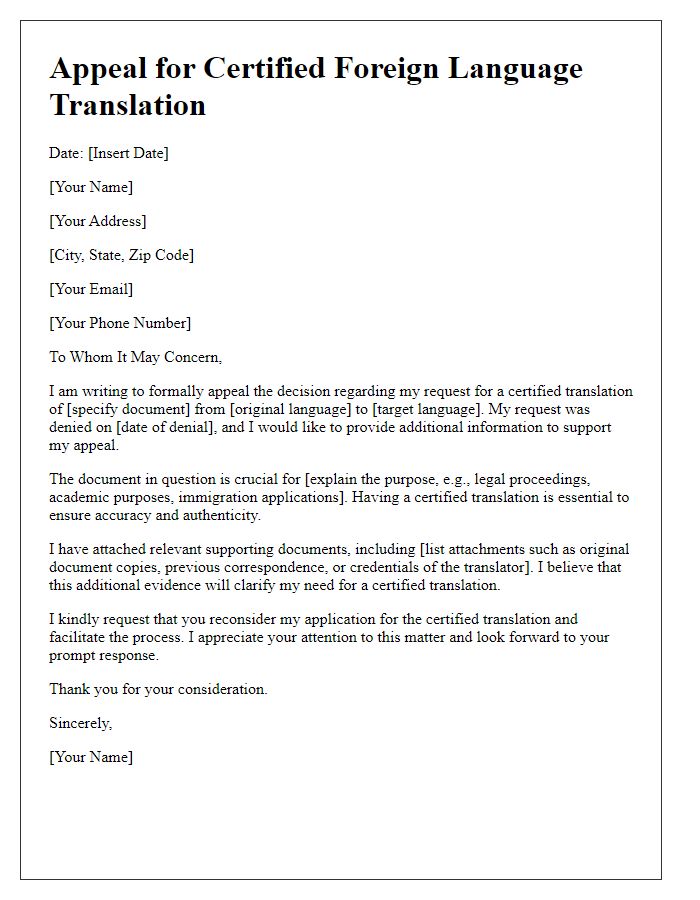Are you looking to bridge the language gap with your international connections? Crafting a request for foreign language translation doesn't have to be daunting; with the right template, you can communicate your needs clearly and effectively. Whether it's for business, legal documents, or personal correspondence, a well-structured letter can make all the difference in ensuring accurate and timely translations. Ready to learn more about creating the perfect letter template?

Clear and concise introductory statement
Foreign language translation requests require precise articulation to ensure accurate communication. Effective introductory statements should identify the document type, language pair, and purpose of the translation, such as "I am requesting a translation of a legal contract from English to Spanish for a business agreement." Specifying context aids translators in providing a culturally relevant and accurate interpretation of the content. Clear guidelines regarding deadlines and formatting preferences contribute to the successful completion of the translation project.
Specific language pair and dialect details
When seeking a translation, it's crucial to specify the language pair and any dialect preferences. For instance, requesting a translation from English to Brazilian Portuguese entails noting regional nuances and idiomatic expressions unique to Brazil, as opposed to Portugal. Make clear the context of the document, whether technical, legal, or literary, to guide translators in choosing appropriate terminology. Additionally, consider mentioning any specific audience or purpose, such as academic, business, or casual communication, to ensure the tone and style align with expectations. Highlighting any deadlines can aid in prioritizing the translation process effectively.
Deadline and urgency of the translation
In an increasingly globalized world, the need for efficient foreign language translation services has become paramount for businesses and individuals alike. The urgency of translation requests often stems from critical deadlines associated with official documents, product launches, or international negotiations. For example, a company preparing for a significant trade event, such as the Hannover Messe in Germany, may require timely translations of marketing materials and product specifications to engage effectively with a multilingual audience. Furthermore, legal documents, like contracts or patents, often necessitate precise translations within short timeframes to ensure compliance with regulatory requirements. In such scenarios, professional translation services offer expedited options to meet urgent demands, enabling seamless communication across language barriers.
Purpose and target audience of the document
A foreign language translation request involves needing an accurate transformation of a document's content into another language while preserving its original meaning and intent. The purpose of such a document may include legal contracts, marketing materials, technical manuals, or medical records. The target audience can vary widely, ranging from multilingual consumers in a global marketplace, legal professionals engaged in cross-border agreements, to medical personnel looking to communicate effectively with non-native patients. Accuracy and cultural sensitivity are crucial in maintaining the integrity of the message, ensuring it resonates appropriately with the intended recipients in their native language.
Contact information for follow-up and clarification
Effective foreign language translation requires clear communication channels. Contact information, including email addresses, phone numbers, and time zones, should be specified for follow-up and clarification purposes. For instance, providing an email address such as example@domain.com ensures written communication can occur promptly. Including a local phone number, like +1-234-567-8901, allows direct conversations for urgent inquiries. Additionally, specifying availability by including time zones (e.g., GMT+1) helps facilitate scheduling discussions. These details enhance the translation process, ensuring accuracy and understanding of the original content.
Letter Template For Foreign Language Translation Request Samples
Letter template of inquiry for translation of documents into a foreign language.

Letter template of application for accurate foreign language translation.

Letter template of notification for ongoing foreign language translation project.

Letter template of clarification for specific foreign language translation needs.










Comments